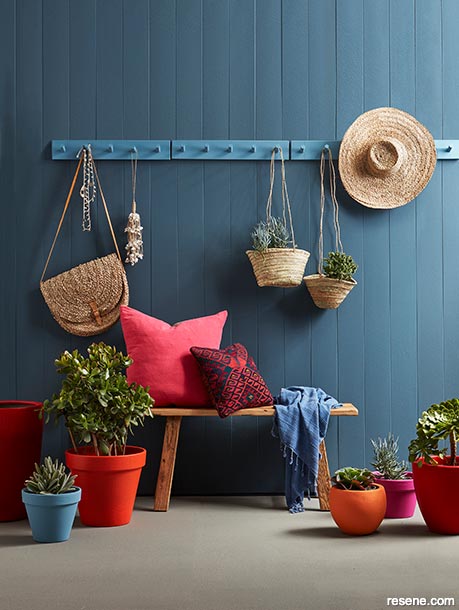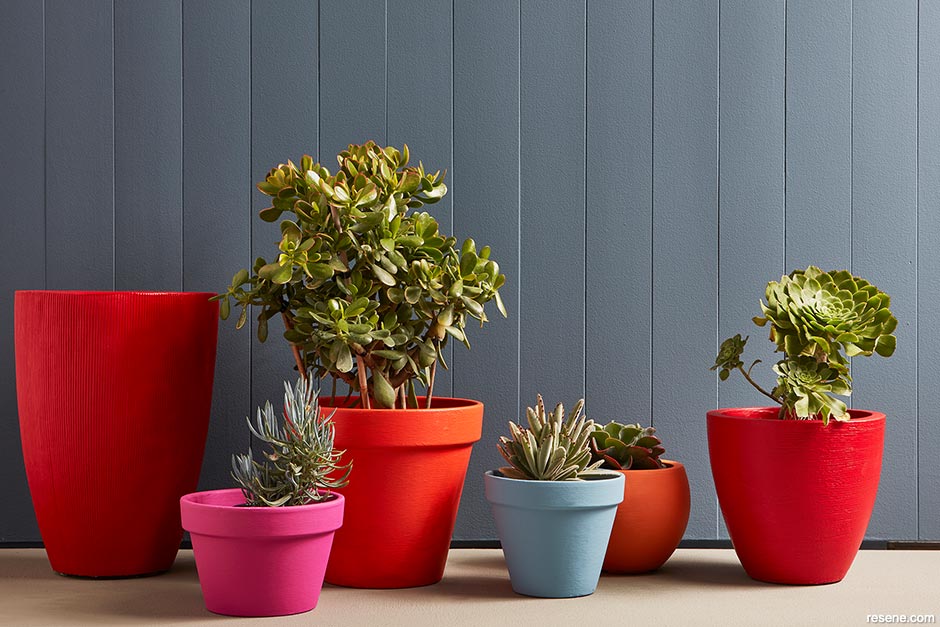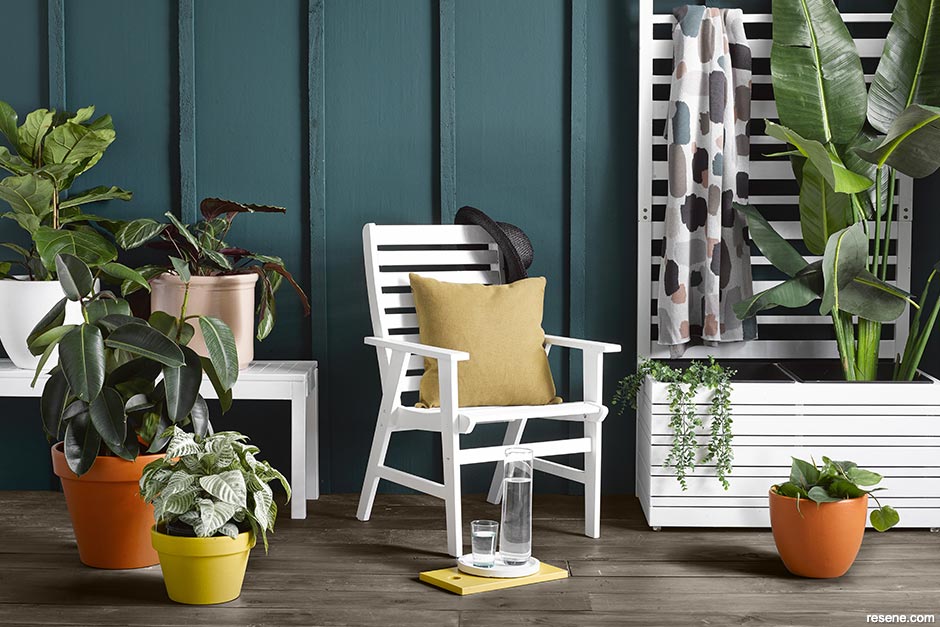From the Resene decorating blog
How to create a feature wall to protect, define and anchor your outdoor space.

If you’re short on space, even a small planked wall like this one in Resene Safehaven can help create an invitation to linger awhile longer outdoors. The bench seat has been sealed and protected with Resene Furniture and Decking Oil so that it’ll stand up to the elements for years to come, and these hooks in Resene Lazy River can help get things up off the ground where they’ll stay nice and day. Project by Claudia Kozub, image by Wendy Fenwick.
Colour, pattern and texture are all popular methods for creating interesting feature walls inside the home, but they can also be useful techniques for both practical and decorative reasons to liven up the spaces just outside your doors. Not only can a feature wall help inject some much needed style to a boring backyard, it can also provide protection from the elements or privacy from neighbours, break up an open or awkwardly shaped area for a more intimate space, or even be used to create an illusion that there is more space than there actually is.
With the right design, an outdoor feature wall can provide much needed shelter from the sun, cut down on glare or slow down breezes.
“Don’t put in a solid wall to divert the wind completely,” advises Lynn Cairney of Fusion Landscape Design. “It will just find another path and create swirls. Try using a screen to tame the wind into a gentle breeze rather than a surface where it’ll hit it and go around.”
If you have an unsightly outlook you want to distract from or hide a gloomy forgotten area that needs energising, introducing a feature wall could be the magical solution to shift focus to something much more attractive and make the area more inviting, says landscape designer Xanthe White.
“They’re especially useful when you want to create a closed view rather than an extended view. You might borrow an aspect of the view – like some beautiful trees – and link them to your outdoor room. It’s almost like pulling the curtains, allowing you to control the space with a vertical ploy.”
If you decide to put a feature wall into your garden, don’t do it half-heartedly, suggests Xanthe. Get creative and inject your personality into the area. “Like all design, you need to have a strong idea and a deliberate focal point. It’s about building the right frame to create a beautiful picture.”
Xanthe says to start by deciding whether the view you want is inside or outside your garden space. “If it’s an inward composition, do you want everything to lead outside the space, or do you want to hold the composition within it? Work out the direction of the view. Consider where you like to sit in the space and what direction you view it from. Maybe it’s the kitchen bench, so that’s where your focus needs to be.”
It’s important to understand the scale of the garden space to get the proportions right. And if you’re using colour, consider what happens to colour when you use it on a bigger scale. In the bright light of day, colours are a lot more intense outside.

Xanthe recommends that, if you have an iPad, find a drawing app to help you mock up your idea. “Take a photo of your space and create a backdrop in the same colour or texture as your feature wall to see how it looks. Bearing in mind, the image will be a lot flatter on the screen, so this is a good way to test what the volume of colour looks like.”
“For an outside feature wall, the natural light is a lot stronger and has more impact than if you used the same colours indoors. Consider how the light changes in the space during the day. It is a lot different in the morning to the evening.”
You can use all sorts of materials to create a feature wall. Paints and wood stains are the most affordable and effective for a quick impact, but be aware that colour affects the temperature of a space. You can attract heat with warmer colours or reflect it with cooler hues.
Dark exterior colours have always held appeal. While there will always be a place for black and charcoal, the trend has moved towards more character dark colours.

Think sooty faded black like Resene Dark Web, brackish green like Resene Waiouru, bruised purple-grey like Resene Rocky Mountain, bitter brown like Resene Sambuca and briny blue like Resene Liberty. These are stormy, twisted colours that on the one hand can be brooding and torrid, but on the other hand can be comforting and enclosing.
“Look at the space and say to yourself, ‘I don’t like it because it’s dark, or it’s glary, or it feels narrow, or it feels like I’m looking at the back of something.
“Colour can claim that space so you control it with your own composition. But remember, blue makes spaces bigger and red makes them shorter. If you want to expand the space, move into the blues.”
People have personal connections to colours so choose one you love. Then contrast it in your planting. “If you paint a wall red, plant something purple in front of it. Go in the opposite direction to make it pop. If you’ve been bold, work with that colour,” says Xanthe.
Part of the beauty of a garden feature wall is that it doesn’t have to look shiny and new. A weathered look is perfect. Rusted metal, worn timber, mossy stone or distressed paint can give a natural appearance that blends in with your landscape. You can use glass or Perspex, even mirrors to enlarge the space, says Lynn, but take care that you don’t position them where they reflect sun. A shaded area is perfect.
Think about durability, says Xanthe. “If you’re attaching a screen to a wall or fence, consider the effect of growing things on it and what that will do to the materials.”
Any soil put against the screen can affect it, and if you are planting on the wall or screen, you’re creating depth. It’s not just a flat surface you’re dealing with. It’s three-dimensional. Climbers grow out, not straight up.
While garden sculptures are commonplace, art and photography is usually limited to the indoors due to the difficulty in protecting it from the weather. However, Resene testpots contain exterior grade paint so can be easily used to create a feature mural or artwork in your backyard.
A vertical wall of planting is another option that creates a lush green backdrop for most of the year, then a plant like a flame vine produces a hot shot of seasonal colour for a short period. Use wires to train plants up your wall for an espaliered effect which creates a graphic visual form. You can be as creative as you like with these forms.
Of course, you will want to enjoy your garden at night so smart lighting is essential. Cool light makes spaces cooler and warm light enriches. Before deciding on the lighting, get two torches, one with a warm light and the other with cool and shine them through your greenery at the wall to see which effect you like best.
Look for opportunities to create shadows using the light at different angles from high in the trees or off to the side. Shine the light through the greenery to explore beautiful textures from the leaves. Move the torch in different directions and have fun seeing what you find. When you put light into the space, suddenly you have movement and a changing palette of light and dark.
When there’s a lot going on during summer, rethinking your garden design is probably just one too many things for your to do list. It’s better to wait until autumn, advises Xanthe. “Look at how the spaces change with the seasons and do it while there’s a happiness factor – in between seasons. Autumn is a great time to take stock, get organised and experiment.”
While a white picket fence is certainly a desirable look, using white outdoors can create a lot of glare and isn’t ideal in areas where you’re looking to pull up a chair and stay awhile. Try mid-range and darker colours or Resene timber stains for a look that’s easier on the eyes.
If you are choosing a dark colour for exterior use, ask for Resene CoolColour paint or wood stain. It has been specially formulated to reflect some of the sun’s harmful UV light, and protect your paint, stain and cladding.
An outdoor feature wall is a great place to try out some fun timber stain colours. Resene Woodsman natural wood stains come in a whole spectrum of garden friendly shades such as Resene Totem Pole, Resene Woody Bay and Resene Heartwood.
If light autumn showers try to derail your DIYing, Resene Umbrella Additive is an additive for exterior waterborne coatings providing rapid protection from light showers even before the coating has dried. Once applied, a coating containing Resene Umbrella Additive quickly starts to build a protective shell that then extends throughout the whole coating. Water is able to evaporate from the coating allowing it to dry but showers and light rain simply roll off.




February 09, 2019
Looking for extra inspiration? Visit your local Resene ColorShop or www.habitatbyresene.co.nz for more colour and paint ideas and inspiration.
Book a colour consult | Ask a Colour Expert | Ask a Paint Expert
Resene's decorating blog
Paint your home beautiful! Discover the latest decorating trends, tips and colour news.
![]()
Previous «
Building a Pacifica look with an eastern flair
![]()
Blog home
View the latest trends, tips and news
![]()
» Next
Keep it white or go for colour?